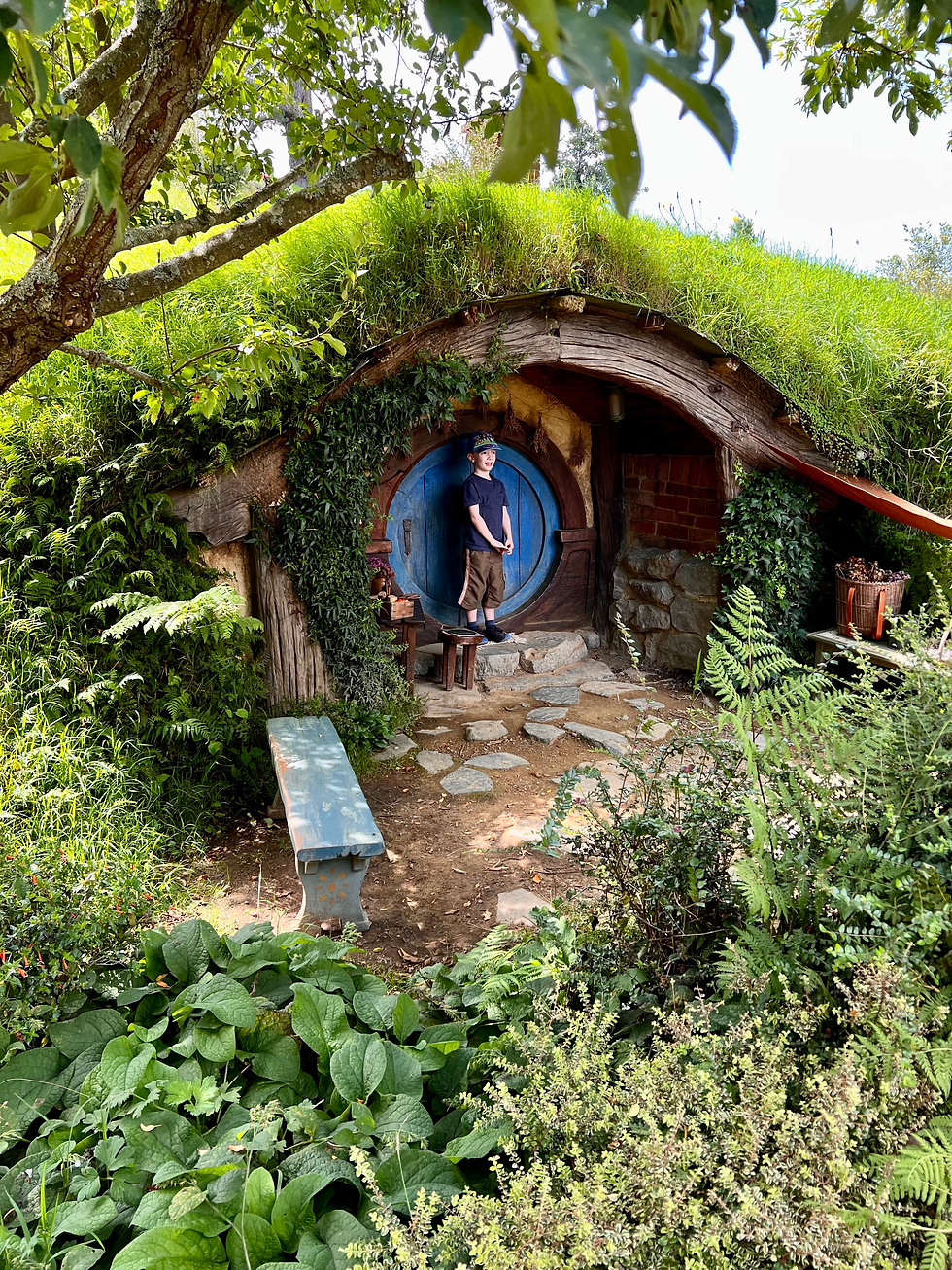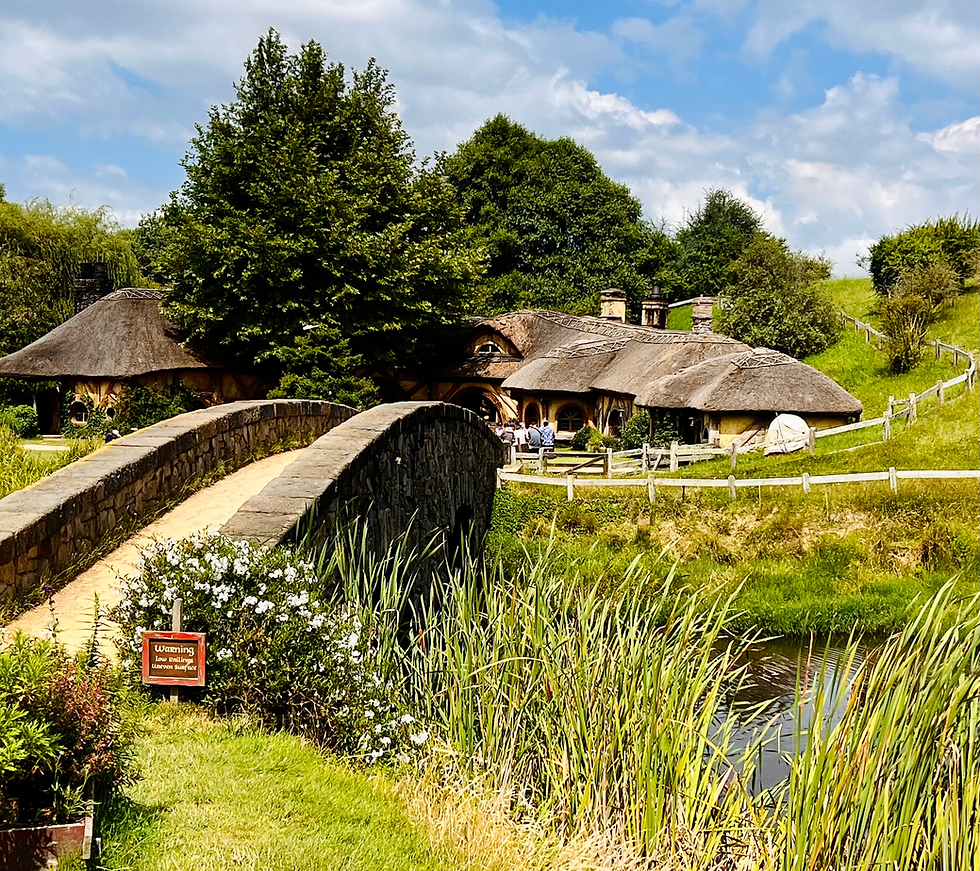
January 17, 2023
“In a hole in the ground there lived a hobbit. Not a nasty, dirty, wet hole, filled with the ends of worms and an oozy smell, nor yet a dry, bare, sandy hole with nothing in it to sit down on or to eat: it was a hobbit-hold, and that means comfort.”
- J.R.R. Tolkien - The Hobbit
I had to go. Of course I had to go. To come this far and not go seemed akin to a mortal sin.

In 1998 the film director Peter Jackson was traveling by helicopter over the North Island of New Zealand. At that time the whole venture seemed an enormous risk. After years of wrangling with the Tolkien estate, Jackson finally acquired the rights to the story. Not, The Hobbit not the Silmarillion, just The Lord of the Rings. That story was big enough.

He had made two key decisions. The first is he would film the story as a trilogy and approach it as a history, as if all of it really happened. The second is he would film all three installments at once in order to save cost and film them in his native New Zealand.
We worked with many artists but perhaps most important was Alan Lee, the concept artist and designer whose art work became the look of the films. Alan was with Peter in the helicopter. They saw a tree, that would eventually become the “Party Tree” next to a pond on a 800 hecto-acre sheep farm owned by Russell Alexander.
He cast mostly lesser known actors, Sean Connery turned down the role of Gandalf because he thought the story made no sense. And it would take over a year to complete principle photography.

.
For many, the story was felt that it could not be filmed. It was too large, to unwieldily, and to complex a tale.
However, Jackson had an abiding love of the source material and felt he knew how to get it done. New Line Cinema gave him 300 million dollars to do it. The landscape of New Zealand would ultimately be the secret to the films monumental success.
So here was Peter and Alan in the helicopter trying to find a location for the beginning of the story. He was looking for Hobbiton and a land that reflected his vision of the shire. They found a farm owned Russell Alexander. It was a 800 hecta-acre cattle and sheep ranch that had some unobstructed views free of power lines and modern buildings. After some initial negotiations a price for rental was agreed to and work began.
It took 18 months to complete the set which is mostly an outer facade of the village. All the interiors were shot at a film studio. At one point the New Zealand army helped with heavy equipment. Sewers and power were to be considered and during the construction and filming 400 people a day had to be fed.
Gardeners were brought in to plant the flowers and crops. Jackson wanted the place to look “Lived in” so it was important everything looked overgrown. This work started a year before the filming would begin.
The original set was not built to last. It was mostly constructed of untreated timber, plywood and polystyrene. It was torn down and the land was restored.
Below is what the set looked like in the years after The Lord of the Rings finished filming.




In 2002, due to the success of the films, various Kiwi entrepreneurs began organizing tours of LOTR sites of which Hobbiton was the most accessible. Even though there were only outlines white plywood against the hills. the tours were a hit. Sheep were living in the hobbit holes.

In 2009, Jackson’s company at long last acquired the rights to The Hobbit. It was decided, not without controversy, to expand the thin prequel novel to three more films. Hobbiton needed to be rebuilt. This time there were more scenes there and they recreated the set on the same property with more substantial materials. When filming finished, they again moved to take it down but by then the farm owners recognized they had a gold mine. — They had found the “One Ring”. There was money to be made. Lots of it.
Today over 13,000 people visit the set annually at a cost of $50 each minimum. It is still owned today by Russell Alexander, the sheep rancher.

So, are you ready for the tour?

We drove from the valley below the farm. It was long and flat with corn fields beside the rows hidden behind well trimmed hedge rows. I was wondering where we were going since the set was supposed to be on a hill side and Google said it was only 5 minutes away. We turned to a side road and sure enough we began climbing into some foot hills. Sheep were everywhere. Alexanders’s farm has 13,000 head of livestock.




We arrived at the gate. To the right was a helicopter that someone brought in a private tour!!!!???


The lot was busy but efficient. With Disney like precision we were grouped and put on buses for the 10 minute drive to the set. I was feeling more than a little cynical about the whole venture. Would this be a slipshod presentation then a forced reentry into a gift shop for over priced t shirts?



To my delight, it was not that at all. The park, because that is all that you can really call it now, is lovingly recreated and so realistic that you swear a Hobbit would pop out at any moment to check his garden. Their is even smoke coming out of some of the chimneys.






The park maintains a large staff of gardeners that tend to the many gardens. But, everything is done in an old fashioned manner. No steel rods, no fake plants.



The park has added many more Hobbit holes than in the original film. About 44 in all. You can see from the pictures some of the holes are quite small, or “Hobbit sized”, while others are larger. This was for the forced perspective shots and the different sizes of the actors. The actor Elijah Wood, who played Frodo, is almost as tall as Ian McClellan, who played Gandalf, in real life.



This is the cut in the road where Bilbo runs through saying, ”I’m Going on a adventure”!

Here ’s Sam’s House.


This is the “Party Tree” and the “Party meadow”. The tree is alive and 130 years old! It was the original tree that made Jackson and Lee think this was the right spot for the Shire.. This species of tree only lives around 150 years so we may not have it much longer.



We had a charming tour guide that filled us with facts about the filming and there was ample opportunity for picture taking. She was from North Carolina and here traveling on a work visa. The weather was splendid.
Below is the bridge to the Green Brier inn






And here it is - Bag End - The home of Bilbo and Frodo.




You will note the large tree at the top. This was part of Lee’s original drawing of the site. Jackson loved the concept and a living tree was moved to the site. Alas, movie sets are temporary things and the tree died. So when it came time to film the hobbit they needed a replacement. So this one is fake. It in made of steel and molding. Every leaf, over 250 million of them, was glued on.
When it was time to begin filming the Hobbit Peter Jackson became seriously ill. He suffered a perforated ulcer and the production was delayed by 2 months. When he returned to the set he looked at the tree and noticed the leaves were not the right color of green.
He ended up hiring dozens of university students who removed every leaf, repainted them, and glued back all 250 million of them.

At last, the filming would begin.
So after all this effort, 18 moths of planning and construction, and hundreds of man hours it was all over in only 13 days. The filming was complete for this amazing set.
The total film time for the Hobbiton set was only 4 1/2 minutes of the films.
…….they were great minutes though. Really great.
When the first trailer came to theaters - everyone knew it was going to make history.

Comentários